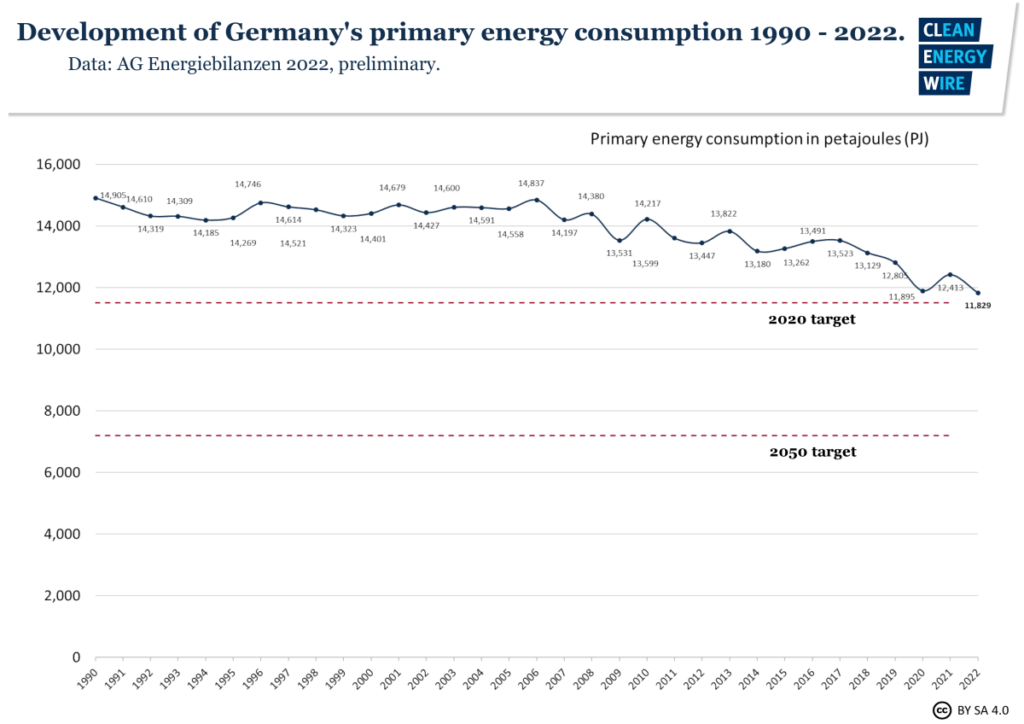Although overall energy consumption fell, Germany’s emissions declined only slightly: because coal-fired power plants stepped in for Russian gas. A leading German energy think tank argues that Germany has to undertake structural reforms to get on track. Nevertheless, Germany’s emissions are lower than ever before – evidence that Germany can hit targets by replacing fossil fuels with renewables. The catch is that once replaced, fossil fuels must be eliminated from energy production altogether. Experts think that Germany can still phase out all coal-fired generation by 2030.

German energy minister Robert Habeck. (Photo by Stephan Röhl, CC BY-SA 4.0)
Russia’s war on Ukraine and the energy embargos put in place both by the EU and Russia are making themselves felt on Germany’s climate targets. Since Russian leader Vladimir Putin cut off Germany’s gas imports last year, the country – one of the world’s largest gas users – has struggled mightily to cut back energy use and replace gas with renewable energies or natural gas imports from elsewhere. Thus, even though the Green Party is a member of the coalition government and in charge of the Ministry of Economic Affairs and Climate Action, Germany has burned more coal than it planned. The upshot: Germany emitted 761 million metric tons of greenhouse gas, just slightly less than in 2021.

Energy crisis pushes German energy use in 2022 to lowest level since reunification. (Graph by Clean Energy Wire, CC BY-SA 4.0)
“The increased use of coal and oil annulled the reductions in emissions through energy savings,” according to Agora Energiewende, a Berlin-based think tank.
The new figures are dispiriting for the country – and Europe as a whole – as most experts agree that the conditions for sinking emissions were abundantly in place. After all, the new government has overseen record buildouts of both solar and wind energy. Solar PV capacity rose by around 26 percent (to 7.2 gigawatts) in 2022, according to preliminary ministry figures, which boosted cumulative solar capacity beyond 65GW. (One gigawatt is equivalent to about three million solar panels, or enough energy to power as many as 770,000 homes.) Onshore wind power generation increased, too, though by just 2GW, bringing the total in Germany to 58GW. Germany’s intention is to add 10GW a year to its electricity supply, which would put it within reach of its 2030 goals.
Moreover, the wildly fluctuating prices of fossil fuels played a central role in sinking energy consumption in Germany by nearly 5 percent, making it the lowest ever. During some weeks in 2022, the price of natural gas soared to ten times its price in 2021. According to Germany’s grid authorities, the average price of gas doubled last year. In tandem, the high cost and friendly winter temperatures encouraged homeowners to skimp, and industry to save and even cut production, in some instances. New energy conservation laws mandated that public buildings shut off lights at night and that room temperatures be set at no higher than 19 degrees Celsius, among other stipulations.
Yet, lower consumption was simply not enough to meet Germany’s reduced emissions’ goal. Natural gas covered around a quarter of Germany’s energy demand in 2022, the second largest energy source after oil. More than half of it hailed from Russia. Although energy minister Robert Habeck traveled to the Gulf states and elsewhere to secure new gas supplies, he was only partially successful. Newly built LNG ports on the Baltics and North Sea coasts were not yet operational in 2022.
The discouraging result: the gap in German supply was filled largely with brown coal, the high-carbon fuel option in the European mix. A stinging setback for the German government, in the summer, Germany opted to reactivate several mothballed coal-fired power plants and to extend others. According to the Agora report: conventional power plants generated 302 terawatt hours of electricity. Of this, lignite-fired power plants supplied the largest share with 109 terawatt hours, an increase of 7 percent compared to 2021. Hard coal-fired power plants generated 20 percent more than 2021, accounting for 60 terawatt hours. By contrast, generation from gas-fired power plants fell by 16 percent. The amount of nuclear-supplied electricity dropped by half, to just 33 gigawatts.
However, energy use and emissions balances were not evenly spread across Germany’s sectors. Industry, for example, managed to cut its emissions output by 8 million tons of CO₂. While praiseworthy, Agora Energiewende notes that even this sector is not on a path to hit its 2030 targets.
Nevertheless, industry is a star performer compared to the transportation and buildings sectors. The former exceeded its annual goal by 113 million tons of CO₂, the latter by 5 million tons. According to Spiegel magazine, the reasons for the missed targets were the renewed increase in traffic volume following the Corona decline and the lack of political instruments to reduce emissions. The federal traffic ministry lies in the hands of the liberal Free Democratic Party, or FDP.
Despite these discouraging results, Agora Energiewende and Habeck’s ministry think that Germany can still hit its 2030 targets. They point out that Germany’s share of renewable electricity generation climbed by about five percentage points in 2022 to 47 percent of total consumption – an increase of around 10 percent compared to 2021. Germany has to forge ahead with ever more renewable expansion and cut back on coal and oil use, which should happen once alternative gas supplies are opened and coal generation phased out by 2030, which Habeck believes is possible.